BTR "CENTAUR"
Work on the "wheeled tank" began by OTO Melara and Fiat at the end of 1984 and was based on the experience of creating in 1982-1983. armored car Fiat 6636 wheel formula 6x6. The installation of a turret with a 105-mm gun increased the mass of the vehicle by at least 6-7 tons, so a fourth had to be added to the three axles so that the vehicle's cross-country ability would not deteriorate. The choice of overall dimensions of the machine was determined by an intractable compromise between the need for a larger internal volume of the hull to accommodate the turret turret and the restrictions imposed by the dimensions of the cargo compartment of the C-130 Hercules military transport aircraft.
In April, 1985 began testing the demonstration machine without a reservation. The main purpose of the tests was to work out the undercarriage, especially the new hydropneumatic wheel suspension, and to check the layout of the machine in terms of ease of maintenance of the 105-mm gun.
The first B-1 vehicle with full armor and armament was handed over for testing in January 1987, followed by five more by the end of the year. In total, ten B-1 armored vehicles of an experimental batch participated in the tests. In 1990, the Italian armed forces received the first ten B-1 Centaur armored vehicles, and in 1991 their full-scale production began at the IVECO Fiat plant in Bolzano with a production rate of ten vehicles per month.
BM B1 Centaur
It should be noted that the B-1 "Centaur" armored car occupies a special place among armored wheeled vehicles. Formally, it is classified as a BRM - a combat reconnaissance vehicle, but which is not entirely correct. Exceptionally powerful armament for a wheeled vehicle (a 105-mm rifled gun with a high muzzle velocity) makes it possible to remove quotes from the expression "wheeled tank" in relation to this vehicle, especially since in the Italian army the "Centaurs" replaced the tanks - the American M47 .
The body of the armored car is welded from steel armor plates of various thicknesses. In the frontal part, the armor is resistant to 20-mm shells, from the stern and sides - to hit by 12,7 mm caliber bullets. The engine compartment is located in the front of the case on the right side. The engine is a six-cylinder water-cooled diesel engine with a turbocharger IVECO Fiat MTSA V-6 with a capacity of 520 hp. With. In addition to the Centaur armored vehicles, various variants of the V-6 diesel are installed on the VCC-80 tracked infantry fighting vehicles, the Argentine TAM tank and the Italian Ariete main battle tank. The car used a West German automatic six-speed (five forward, one reverse) gearbox ZF SHP-1500. The engine, cooling system and gearbox are structurally made in the form of a single unit and are separated from the rest of the body by fireproof partitions. An automatic fire extinguishing and alarm system is installed in the engine compartment.
BTR Centaur
To the left of the engine compartment there is a control compartment with a driver's workplace (the driver's seat is height adjustable). Outside of a combat situation, the driver controls the vehicle, observing the terrain through an open hatch. In combat, observation is carried out using three observation periscope devices. Instead of a central observation unit, a non-illuminated night vision device can be installed.
The central part of the body is occupied by fuel tanks and a tower polik. There are two 12 projectiles on the cannon, rechargeable batteries, a filtering unit and a hydraulic winch with a pull of 10 t in the stern. The aft armor has a hatch used to load projectiles.
All eight wheels are leading, the first two pairs are steerable, but at speeds up to 20 km / h you can turn the rear pair of wheels. The wheels are controlled with the help of hydraulic boosters. Wheel suspension independent hydropneumatic. The machine is equipped with a system of centralized regulation of air pressure in tires. All wheels are equipped with disc brakes.
BM B1 Centaur
The three-person turret, armed with an 105-mm LR cannon with a length of 52 caliber, was developed by Melara OTO It is installed closer to the hull aft. The commander of the armored car is to the left of the gun, the gunner is on the right, the loader is behind the gunner. Hatches in the roof of the hull are located above the commander and loader seats.
The LR gun is similar in internal ballistics to the 105mm L7/M68 tank gun. The gun is equipped with a device for purging the bore after a shot, a highly efficient device that absorbs up to 40% of recoil, a muzzle brake and a thermal protective cover. The recoil of the gun when fired is 14 tons, in order to extinguish it, a special hydro-pneumatic recoil system with a barrel stroke of 750 mm after the shot is installed. Shooting is possible with all standard 105 mm NATO rounds, including HEAT rounds. The ammunition for the gun is 40 shells, 14 of them are stored directly in the turret. A 7,62 mm M42/59 machine gun is paired with the gun (mounted on the left side of the gun), another machine gun can be mounted on the roof of the turret. Ammunition for machine guns 4000 rounds. On the sides of the tower there are four smoke grenade launchers.
The rotation of the turret and the aiming of the gun in the vertical plane is carried out by means of electro-hydraulic drives. The elevation angles of the implement are from -6 ° to + 15 °.
The armored car is equipped with a Galileo modular fire control system. Its main subsystems are the commander's and gunner's sights, a digital ballistic computer, atmospheric state sensors, indicators and control panels for the gunner, commander and loader. The commander of the armored car has a stabilized daytime panoramic sight with 2,5x and 10x magnification. An image intensifier is integrated into the sight, which allows for observation and aiming in low light conditions. The sight has a circular rotation in the horizontal plane, in the vertical - from -10° to +60°. The gunner has a combined stabilized day/night sight with a built-in laser rangefinder. The day channel has a 5-fold gain, the image from the infrared channel is duplicated on the indicator installed next to the commander's seat. The shooter also has a telescope with an 8x magnification paired with the main sight. The commander observes the left sector through four periscopic viewing devices, the gunner - the right sector through five fixed periscopic viewing devices. The ballistic computer is based on a 16-bit Intel 8086 processor. Despite the fact that the gun is stabilized in two planes and has a modern fire control system, according to Western press reports, the Centaur cannot fire on the move.
But some changes were made to the test results of the first six cars: the hull width was somewhat reduced (for more convenient placement in the C-130 "belly"), a small V-shape was attached to the bottom for better mine protection, the dimensions of the hatch in the stern armor were reduced .
Serial production of armored cars B-1 "Centaur" was completed in 1996 year. The armament of the three armored cavalry regiments of the Italian army was transferred 400 machines. The interest in armored cars of this type is shown by the command of the Spanish armed forces, which intends to purchase 30 wheeled tanks.
Checking in combat conditions armored vehicles. "Centaur" took place during the peacekeeping operation "Restore Hope", held in Somalia under the auspices of the UN. At the end of 1992, eight wheeled tanks from the 19th Cavalry Regiment were sent to the African continent as part of a mixed armored company (in addition to the Centaurs, it included five more M60A1 tanks). Two airborne regiments, which formed the backbone of the Italian contingent of UN forces, were reinforced with heavy equipment. "Centaurs" were widely used to conduct reconnaissance raids, blockade the main lines of communication of the separatists and escort convoys with humanitarian cargo. During the first four months of 1993, seven armored vehicles covered 8400 km on Somali highways and off-road. For all the time there was not a single serious case of equipment failure. The eighth car was not used, as its engine failed immediately upon arrival in Somalia. Before the end of the UN mission in Somalia, the eighth Centaur was commissioned, and two more vehicles were transferred from Italy.
Under the conditions of constant tire damage, the system of centralized pressure control in pneumatics proved to be especially well-proven; of course, it could not get rid of punctures, but it allowed it to complete the task.
For the whole company, there were no worthy targets for 105-mm guns, of which they fired only at firing practice at an impromptu training ground in the Gialalksi area. But the commander's panoramic sight with an image intensifier was very useful. "Centaurs" were very often used as mobile observation posts along the Imperial Highway. The vehicles occupied positions 500 meters from the road and the crews, using sights as night vision devices, monitored night life, if necessary, pointing Italian patrols at its suspicious manifestations.
VHF radio stations installed on armored cars proved to be insufficiently powerful, it was considered necessary to have a medium-range HF radio station at least on commander vehicles. Oddly enough, in very hot climates, the crews did not use the air conditioning system, preferring to open all hatches for plowing.
Typical counterguerrilla operations were carried out in Somalia. The enemy was poorly armed and poorly trained, however, it quickly became clear that the armor protection of the Centaurs (as well as all other armored vehicles) was clearly not sufficient, it did not "hold" the armor-piercing bullets of the DShK machine guns, not to mention the RPG-grenades 7. As a matter of urgency, the British company Royal Ordnance ordered twenty sets of dynamic protection units for the turret and sides of the ROMOR-A hull. Ten sets were installed on the "Somali" "Centaurs".
In the summer of 1997, the “Centaurs”, together with armored vehicles Fiat 6614, of the Guards Cavalry Regiment, took part in Operation Alba to prevent the civil war in Albania.
"CENTAUR" II
In 1996, the Italian armed forces issued technical requirements for the second generation Centaur wheeled tank. The prototype was made in the same year, and in 1997 it was submitted for testing. The aft part of the hull was lengthened by 335 mm, which made it possible to increase its internal volume. Ammunition for the 105-mm cannon on the new version of the Centaur BRM is located only in the turret, and in the enlarged aft compartment there are places for four fully armed soldiers. Additional armor plates are installed around the tower, the upper parts of the two rear pairs of wheels are covered with screens of steel armor plates. As a result of the improvements, the combat weight of the vehicle increased by 1 ton, the ammunition capacity of the cannon shells decreased from 40 to 16. It is expected that the Italian ground forces will order 150 Centaur II armored vehicles for use as armored reconnaissance vehicles.
BTR "CENTAUR"
An experienced armored personnel carrier was built in 1996. The body of the vehicle was extended by another 80 mm compared to the Centaur II, and the wheelbase also increased, from 4,5 m to 4,8 m. For ergonomic reasons, the body was made higher, the height of the armored personnel carrier on the roof of the body is 1,93 m compared to 1,75 m for the Centaur. The experience of peacekeeping operations in Somalia has shown the need to strengthen armor protection: the armor of the armored personnel carrier can withstand hits of 12,7-mm armor-piercing bullets in the stern and from the sides, and in the front - hits of 25-mm shells. The demonstration vehicle was fitted with a two-man OTO Breda turret, armed with a 20 mm automatic cannon and coaxial with a non-7,62 mm machine gun. During the tests, the 20 mm gun was replaced with a 25 mm gun. In the configuration with the turret installed, the BTR crew consists of three people (commander, gunner, driver) and six more paratroopers are located in the aft fighting compartment. The combat weight of the armored personnel carrier is 24 tons. The turretless armored personnel carrier based on the Centaur can carry 11 people, including the driver.
The armored personnel carrier based on the Centaur meets almost all the requirements set by the French army for the promising VBM wheeled vehicle, the German army for the GTK vehicle and the British army for the MRAV armored car. The only exception is the width of the vehicle, since the armed forces of France and Germany limited the width of the prospective armored car to three meters, while the width of the armored personnel carrier based on the Centaur is 3,28 m. It is possible to reduce the width of the armored personnel carrier by removing the additional armor of the hull or replacing it to another type. It is very likely that the armored personnel carrier will take part in the competition for the supply of armored wheeled vehicles for the armed forces of these countries.
In 1999, the Italian Ministry of Defense entered into a contract providing for the development of a command and staff vehicle, an ambulance vehicle, a self-propelled mortar and an ATGM carrier based on an armored personnel carrier. The Italian army plans to purchase 240 machines of all modifications. The width of the base model, designed for Italy, reduced to 3 m.
On the anti-tank version will be installed rotating tower GRT Breda HITFIST. The tower is mounted 25-mm automatic gun Oerlikon Kontravers, paired with her 7,62-mm machine gun and two launchers ATGM "TOW".
The command and command vehicle has an increased height of the fighting compartment (the total height of the vehicle on the roof of the hull is 2,1). Armament - machine gun caliber 12,7 mm pivot installation. There are no loopholes in the sides of the hull and ramp on the KSHM.
The self-propelled mortar variant involves the installation of an 120-mm smooth-bore TDA mortar on a swivel base inside the crew compartment. Shooting is conducted through a large hatch in the roof of the hull. For self-defense will be used machine gun caliber 12,7 mm on pivot installation. The crew of a self-propelled mortar consists of a commander, driver and four crew members.
On the basis of the armored car "Centaur" was created and tested 155-mm self-propelled unit.
Wheel formula ................................................ ..8х8
Combat weight, kg .................................................... .24.800
Case length, m .............................................. .. 7,40
Forward length with gun, m ........................................ 8,56
Width, m ............................................... ........ 2,94
Case height, m .............................................. 1,75
The height of the roof of the tower, m ........................................ 2,44
Wheelbase, m ...................................... 1,60 / 1,45 / 1,45
Track width, m .............................................. ... 2,51
Ground clearance, m ............................................. 0,42
Maximum speed on the highway, km / h .............................. 108
Cruising on the highway, km .......................................... 800
Fuel capacity, l ....................................... 540
Obstacle obstacles:
rise................................................. ........... 60%
wall height, m .............................................. .. 0,55
trench width, m .................................................... .. 1,55
ford depth, m .............................................. .... 1,2
Crew, pers. .................................................. ..... 4
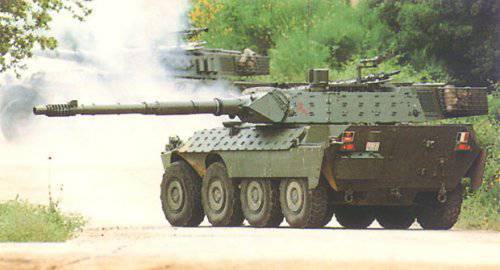
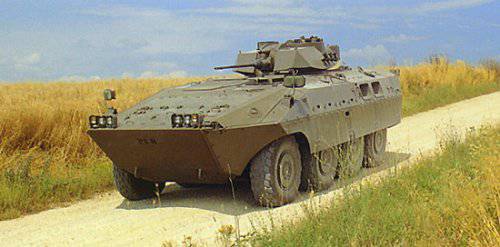
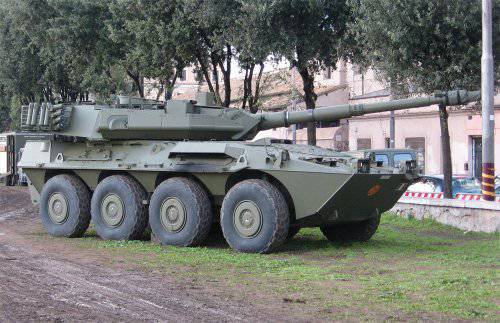
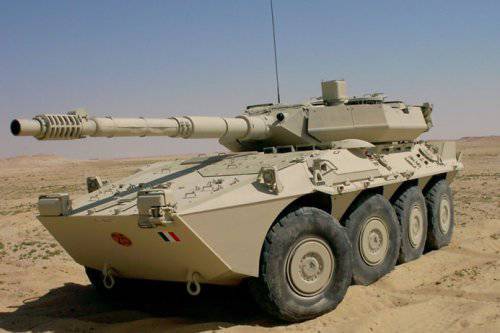
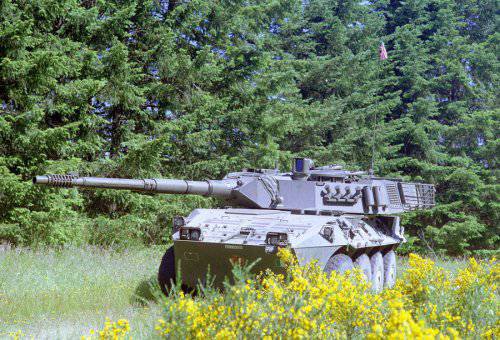
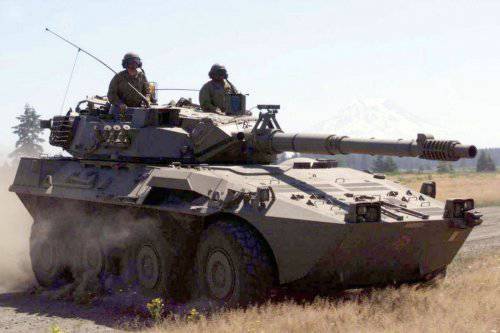
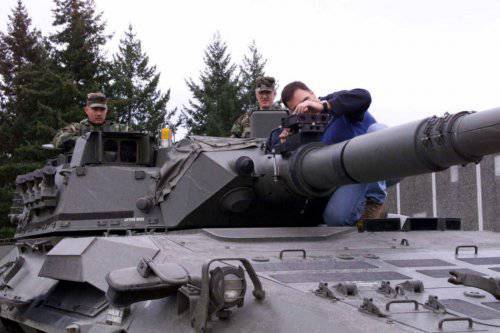
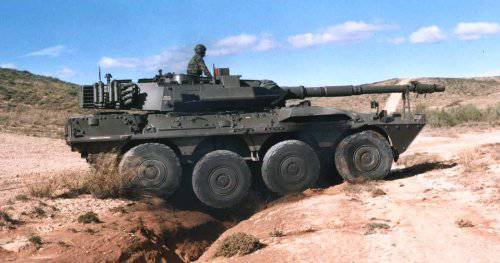
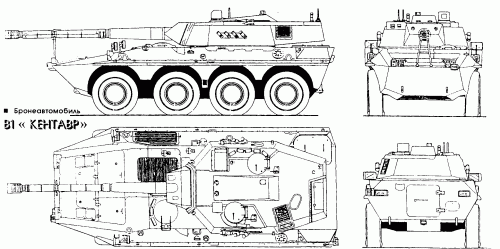
Information